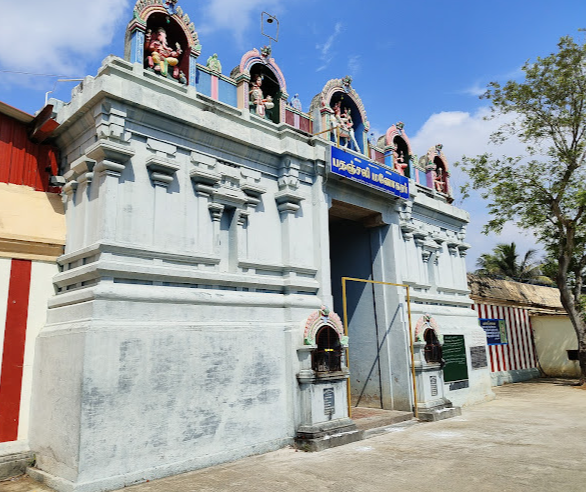Sage Patanjali performed penance, longing to witness Lord Shiva’s cosmic dance. Pleased with his devotion, Lord Shiva performed his divine dance in Thillai (Chidambaram). Sage Vyagrapathar also had the privilege of witnessing this dance. Both sages, overwhelmed with joy, requested Lord Shiva to bless them with the eternal sight of his Ajapa dance and Rudra Tandava. They also prayed for all devotees to receive the divine vision of his sacred feet (Thiruvadi).
Lord Shiva instructed them to go to Thiruvarur, known as Sripuram, where they would witness his dance and Thiruvadi darshan. The sages travelled to Thiruvarur, where Shiva Linga was visible everywhere. To continue their worship, Sage Patanjali took the form of a snake, and Vyagrapathar transformed his legs into a tiger's legs. They offered their devotion at Tiruvarur Kamalamba.
Sage Patanjali later performed penance, holding a Shiva Linga in his hand at Vilamal, a heavenly land called Vimalakka Viram. In response to this worship, Lord Shiva appeared, performed the Aja Bhavana dance, and revealed his sacred feet, known as Rudrapadam. Lord Shiva here is revered as Patanjali Manoharar, and the place became known as Vilamal, signifying the site of Shiva’s Thiruvadi darshan. This vision was witnessed by Vishnu, Brahma, Emperor Musukunda, and various gods. To this day, daily pujas are performed for Lord Shiva’s Rudrapada. Hence, Vilamal is regarded as Tiruvadi Kshetram or Shivapada Sthalam.
Sthala Puranam :
Sages Patanjali and Vyaghrapada were deeply captivated by Lord Shiva’s Ananda Thandavam (cosmic dance) at Chidambaram. However, they wished to witness the divine Ajapa Natanam (silent dance) and Lord Shiva’s sacred Rudra Padam (foot), and thus prayed for this blessing. Lord Shiva instructed them to go to Sripuram (Tiruvarur) to fulfil their wish.
Upon reaching Tiruvarur, the sages found Shiva Lingams scattered all over the ground. To continue their worship, Patanjali transformed into a snake, and Vyaghrapada altered his feet into tiger's feet. They offered their prayers to Goddess Kamalambal, who guided them to Vilamal to worship Lord Shiva.
At Vilamal, Sage Patanjali created a Lingam out of sand, and together with Vyaghrapada, they worshipped it. Lord Shiva, pleased with their devotion, appeared before them, performed the Ajapa Natanam, and showed them his left foot. This sacred foot, known as Vilamal or Rudra Padam, gave the place its name. The Natanam occurred on the northeastern side of the temple, which is why Nandi is seen looking in that direction.
At the temple, Patanjali and Vyaghrapada have their shrines in the Ardha Mandapam and Maha Mandapam, respectively. Since this temple is a Shiva Pada Kshetram (sacred place of Shiva’s foot), Bhairavar here is regarded as the ruler of the Navagrahas, and thus, there is no separate shrine for the Navagrahas.
In the Garbhagriha, devotees can see three forms of Lord Shiva: the Lingam, the Natarajar idol behind the Lingam, and the Shiva Padam in front. It is believed that worshipping Thyagarajar at Tiruvarur and Rudra Padam at Vilamal on the same day helps devotees avoid rebirth.
Connection to Ramayana: According to legend, Emperor Dasaratha visited this temple and worshipped Lord Shiva here to be blessed with children, as mentioned in the Ramayana.
Administration History :
The temple has a rich administrative history, originally established before the 6th to 7th Century, as indicated by Thirugnanasambandar's hymns. It underwent reconstruction as a stone temple during the Chozha period and was further extended during the Nayakas period. Significant renovations were completed with the Maha Kumbhabhishekam held on 30th August 2004 and 12th September 2018. Today, the temple is administered by the Velukurichi Adheenam, located in Thirupugalur.
